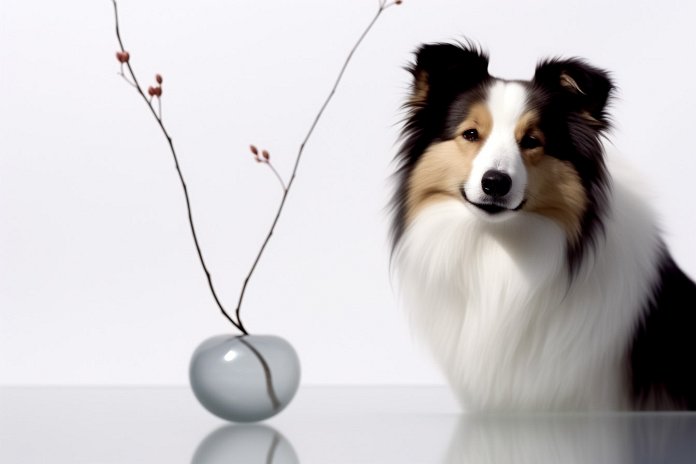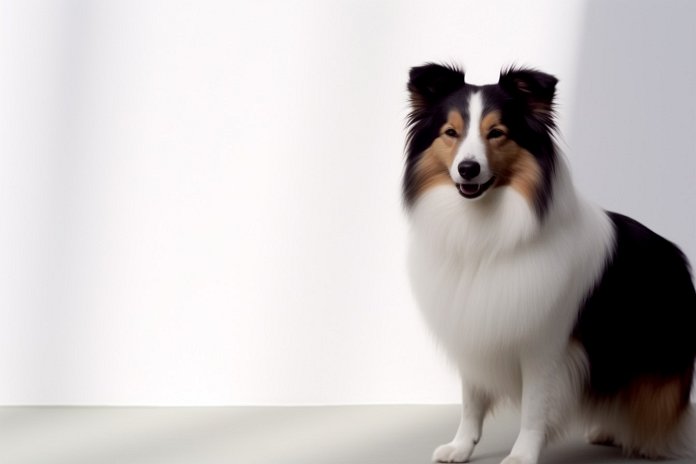
The Cosheltie is a stunning dog that falls into the medium to big size category. It is a mix between the Collie and the Shetland Sheepdog. This breed has thick, long, and rough hair that is straight. It can come in various colors, but the most common are black, brown, white, red, tan, red, or merle. With well-proportioned legs, a long and fluffy tail, a broad and pointed nose, pointed and upright ears, and an inquisitive expression, the Cosheltie has a striking appearance.
Not only is this breed known for its physical beauty, but it also possesses remarkable agility and discipline training abilities. The Cosheltie is highly intelligent and always eager to please. This makes them wonderful family pets as they get along well with children and other animals. However, due to their herding instincts, they might try to herd other animals or even young children. It’s important to keep this in mind and provide appropriate training to redirect their natural herding behavior.
Ahead, we look at Cosheltie dog breed, its history, personality, pros and cons of owning an Cosheltie, characteristics, and must-know facts. We will also examine how to care for this breed and more. Prepare for a tail-wagging adventure into the world of Coshelties!
| Dog Breed | Cosheltie |
| Size | Medium |
| Weight | 18-28 lbs (average) |
| Height | 13-20″ (average) |
| Location | United States |
| Ancestry | Collie and Shetland Sheepdog |
| Date of Origin | 2001 |
| Group | Herding |
| Life Expectancy | 14-16 years |
| Price | $400 – $600 |
| Family | Canidae |
| Scientific Name | Canis Lupus Familiaris |
📖 Breed History
The Cosheltie is a relatively new breed without its own history, so the histories of its parent breeds are often used as a reference. The Collie, which comes in rough-coated and smooth-coated varieties, is a well-known breed. The rough-coated Collie, popularized by the famous TV dog Lassie, is believed to have descended from herding dogs in Wales and Scotland during the 1800s. The Scottish variety was larger and more aggressive, used for herding highland sheep, while the Welsh variety was smaller and friendlier, used for herding goats and sheep. By breeding these varieties with different types of Sheepdogs, the two varieties of Collie were created. The first Collies appeared in dog shows in 1860 in Birmingham, England, under the name Scotch Sheep Dog. They were imported to America in 1879 and registered with the American Kennel Club (AKC) in 1885. The Collie is currently the 37th most popular breed in the United States, and the Collie Club of America, established in 1886, is one of the oldest specialty dog clubs in the country.
The Shetland Sheepdog, also known as a Sheltie, is closely related to the Collie. It is believed to have descended from a mix of Scottish Collie and King Charles Spaniel, which explains its smaller size compared to the Collie. In the 19th century, Shelties were commonly used to herd small Shetland sheep, hence their name. The breed was registered with the AKC in 1911 and is currently the 24th most popular breed in the United States.

🐕 Cosheltie Appearance
The Cosheltie is a medium-sized dog with a rough, thick, and typically tricolored medium-to-long coat. Black, brown, and white are the most prevalent hues, followed by brown, white, and tan, gold, brown, and black, red, black, and white, and blue merle. This breed may weigh up to 30 pounds and stand anywhere between 13 and 22 inches tall. They have a long, fluffy tail, upright, pointed ears, and a long nose. Due to the fact that they are both offspring of the same Collie and Sheepdog breed, the Cosheltie truly resembles a medium-sized Shetland Sheepdog or a small-sized Rough Collie.
| 👀 Eye Color | Brown |
| 🐽 Nose Color | Black |
| 🐕 Coat Color | Black, Brown, White, Red, Blue, Pied |
⚡ Fun Fact: Cosheltie dogs need a lot of social interaction. They desire to always be with someone or around people. This breed hates being left alone.
🐶 Traits & Temperament of Cosheltie
Your Cosheltie will attempt to herd everything that will allow her to since she likes to run and herding is in her genes. Don’t leave the kids unsupervised since you could even catch her trying to herd the little ones. They will go out of their way to understand what you are attempting to teach them because they want to win your favor. They are excellent watchdogs and bark loudly to get your attention since they share the Collie’s protective temperament. They have a high level of intelligence and may even appear to comprehend you better than you realize. The Collie parent breed was the star of the classic television series Lassie, where the canine cast member could converse with humans and intervene to save them in a variety of predicaments.
🤝 Are Coshelties Friendly or Aggressive?
Cosheltie dogs are known for their friendly and sociable nature. They are generally friendly towards strangers but are especially fond of children. These dogs enjoy the company of kids and are comfortable being around them. Coshelties are also cat-friendly and get along well with other dogs. They are a great choice if you want to have multiple dogs or if you enjoy participating in dog meetups. Additionally, Coshelties are considered to be one of the best dog breeds for elderly people, as they are gentle and well-suited for a more relaxed lifestyle.
This breed is known for being:
- Playful
- Protective
- Intelligent
- Friendly
- Responsive
- Docile
- Affectionate
- Obedient
- Loyal
- Lively
- Gentle
- Social
- Elegant
- Hard working
- Herding
🐩 Cosheltie Care & Maintenance
The Cosheltie needs frequent, thorough brushing because of its long, tough fur. The ideal tools to use to brush them are a metal comb and a long-toothed, stiff bristle brush. Every four to six months, many owners take their Cosheltie to be professionally groomed to make it simpler to brush them. To avoid inflammation and illness, you should clean their ears at least once a week and look for mites, waxy buildup, and other debris. It is advised that you wash her teeth a few times a week and clip her nails as necessary to avoid dental issues.
Cosheltie dogs have a higher than average tendency to shed their hair. This shedding is a normal part of their hair growth cycle and varies in amount and frequency depending on their health and breed. If you prefer to avoid frequent vacuum cleaning, you may need to reconsider getting a Cosheltie puppy. Additionally, it is recommended to bathe Coshelties every 4-6 weeks.
🍖 Food: We recommend 2.5 cups daily, costing you about $2.00 – $2.50 daily, or roughly $60.00 – $75.00 a month.
🐾 Exercise: Cosheltie dogs need quite a lot of exercise. Daily walks should be on schedule. If you live an active life, this breed can be a good choice for you.
This dog breed requires to be walked for roughly 10 miles per week, which equates to about 90 minutes of physical activity daily. This consistent moderate exercise regimen will help maintain their physical wellness and significantly contribute to their mental stimulation. Consciously setting aside this time for your furry friend can dramatically enhance their life quality, helping them stay energetic, healthy, and mentally alert.
Did you know: Cosheltie dogs have a higher energy level than other dog breeds. If you want a dog for snuggling on the couch, this breed isn’t the perfect choice for you.
❤️🩹 Cosheltie Health & Issues
Some of the major concerns for Cosheltie Dog Breed can be:
- Deafness
- Von Willebrand’s Disease
- Patent Ductus Arteriosus
- Collie Eye Anomaly (CEA)
While minor concerns include:
- Progressive Retinal Atrophy
- Cataracts
- Hip Dysplasia
🤧 Important: Is Cosheltie hypoallergenic? No.
✨ Bonus: Check out cool, creative, and funny names for Cosheltie.
⚡ Cosheltie Dog Breed Facts
What makes the Cosheltie a great choice for families with young children?
The Cosheltie is a great choice for families with young children because they are known to be good with other animals and have a protective nature. However, it is important to supervise interactions between the Cosheltie and small children, as they may try to herd them.
Is the Cosheltie breed considered a suitable breed for apartment living?
The Cosheltie breed may not be considered suitable for apartment living due to their high energy levels and need for regular exercise. They thrive in a spacious environment where they can run and explore.
How much exercise does a Cosheltie require compared to other breeds?
The Cosheltie requires a moderate to high amount of exercise compared to other breeds. They have a herding instinct and love to run, so daily walks, playtime, and mental stimulation are essential to keep them happy and satisfied.
Is the Cosheltie breed known for being good with other pets?
The Cosheltie breed is known for being good with other pets. They have a friendly and sociable nature, making them generally welcoming towards other animals.
What are other low-maintenance dog breeds similar to the Cosheltie?
Some low-maintenance dog breeds similar to the Cosheltie include the Shetland Sheepdog and the Border Collie. These breeds also have medium to long fur and possess similar characteristics to the Cosheltie.
What are the common health issues that Coshelties are prone to?
Like their parent breeds, Coshelties can be prone to certain health issues. These may include hip dysplasia, eye problems, and allergies. Regular veterinary check-ups are important to address any potential health concerns.
Are Coshelties known to be easy to train compared to other breeds?
Coshelties are generally considered easy to train. Their intelligence and eagerness to please make them quick learners. Consistent and positive reinforcement methods are recommended for training.
Are Coshelties more prone to separation anxiety compared to other breeds?
Coshelties, like many other breeds, can be prone to separation anxiety if left alone for long periods. They thrive on human companionship and may become stressed or exhibit destructive behavior when separated from their owners for extended periods.
Are there any dog breeds similar to the Cosheltie that are suitable for people with allergies?
Some dog breeds similar to the Cosheltie that are suitable for people with allergies include the Poodle and the Bichon Frise. These breeds have hypoallergenic coats that produce fewer allergens.
What sizes of dogs similar to the Cosheltie are best for individuals or families with limited space?
For individuals or families with limited space, smaller-sized dogs similar to the Cosheltie may be a better fit. Breeds such as the Shetland Sheepdog, Welsh Corgi, or Beagle are smaller in size and can adapt well to smaller living spaces.
Is the Cosheltie breed known to be good with children with special needs?
The Cosheltie breed is known to be good with children, including those with special needs. Their gentle and loyal nature makes them excellent companions for children of all abilities.
How does the grooming and shedding needs of the Cosheltie?
The grooming and shedding needs of the Cosheltie can vary. They have long, thick fur that requires regular brushing to prevent matting. They are moderate shedders, so regular grooming and vacuuming may be necessary to manage their shedding.
We use reliable and publicly available data and resources such as AKC and American Canine Registry to ensure that Cosheltie dog breed information is accurate and up to date. If you spot an error, please don’t hesitate to bring it to our attention.